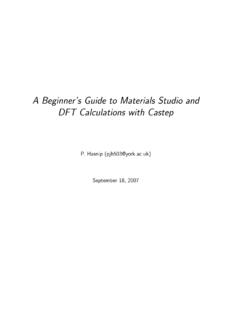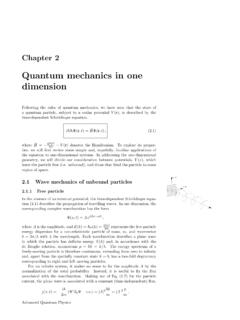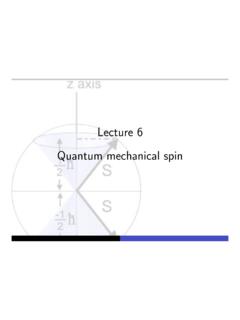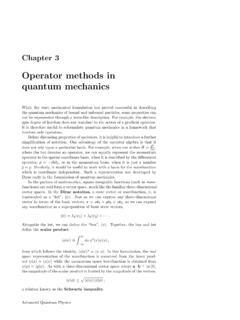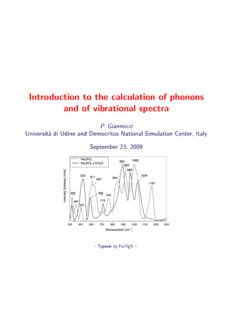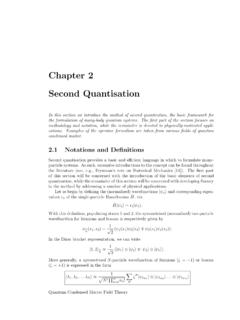Transcription of A Beginner’s Guide to Materials Studio and DFT ...
1 A beginner s Guide to Materials Studio andDFT Calculations with CastepP. Hasnip 18, 2007 Materials Studio collects all of its files into Projects . We ll start by creating a new we ve got a blank project, and we wantto define a simulation cell to perform a Castepcalculation on. First we add a 3D Atomisticdocument .23We re going to start by simulating an eightatom silicon FCC cell, so rename the file ac-cordingly. First we ll create the unit default is space group P1, no symme-try. Silicon has the diamond structure (spacegroup FD3M). By telling Materials Studio thissymmetry it will automatically apply it to theatoms, thus generating atoms at the to add the lattice constant click onthe Lattice tab near the top of the BuildCrystal window.
2 Since FD3M is cubic (FCC) Materials Studio knows onlyahas to be set,and the angles and other lattice constants , and then click on Build .7 Now we ll add a single silicon a silicon atom at the origin, by chang-ing the element from its default and click-ing Add . By default the co-ordinates arein fractionals, but you can change this on the Options we d already told Materials Studio whatthe symmetry of the crystal was, our single sil-icon atom is replicated at each symmetry siteand we now have a shiny new eight-atom sili-con unit can rotate the view by holding down theleft or right mouse button and dragging, ormove it by holding down the middle the mouse wheel, or both the left and rightbuttons simultaneously, to zoom in and default the atoms are shown as little crosseswith lines for bonds, and silicon atoms are colouredbrownish orange.
3 You can always change this ifyou don t like it. The bonds are just guessesmade by Materials Studio based on the ele-ment s typical re now ready to run Castep to find thegroundstate charge density. Click on the Castepicon, which is a set of three wavy lines (to rep-resent plane-waves), and select calculation .11 Materials Studio offers a high-level interface toCastep, with cut-off energy, k-point sampling,convergence tolerances etc. all set by the sin-gle setting Quality . We ll look at how tospecify these things later, but for now we lljust do a very quick, rough calculation of thegroundstate energy and density of our sure the task is Energy , and select Coarse for quality, and LDA for the you want to run your calculations on La-gavulin (or anywhere else you have Castep avail-able) then you ll want to click Files in theCastep select Save Files to save the cell andparam files.
4 By default these are written toa folder in My Documents called Materi-als Studio Projects but be warned cell filesare hidden files, and you won t be able to seethem unless you tell Windows you want to view Hidden and System Files for that you want to run Castep on the PC you re us-ing, you just need to click Run on the Castepwindow. You should see this window appear: Materials Studio is telling you that your systemisn t actually the primitive unit cell, and it soffering to convert it to the primitive cell foryou. For now choose No .Castep runs via a Gateway , which might beon your local computer or on a remote ma-chine. This Gateway handles Materials Stu-dio s requests to run calculations and copiesthe files to and from the Castep Server.
5 14 Since the Gateway is actually a modified webserver it is sensible to enforce some your Gateway is password-protected (recom-mended), you ll need to enter your Gatewayusername and password (which are not neces-sarily the same as your Windows ones).15 When the Castep job is running you will see itsjob ID and other details appear in the job ex-plorer window. You can check its status fromhere, although our crude silicon calculation isso quick you probably won t have time reports back when it is finished, andMaterials Studio copies the results of the cal-culation back. The .castep file is opened au-tomatically so you can see what happened inthe main text output file from castep is dis-played in Materials Studio .
6 It starts with a wel-come banner, then a summary of the parame-ters and cell that were used for the that, there is a summary of the elec-tronic energy minimisation which shows the it-erations Castep performed trying to find thegroundstate density that was consistent withthe Kohn-Sham potential. This is the so-called self-consistent field or SCF condition, andeach line is tagged with SCF so you canfind them <-- SCFSCF loop Energy Fermi Energy gain Timer <-- SCFenergy per atom (sec) <-- SCF------------------------------------- ----------------------------------- <-- SCFI nitial +002 +001 <-- SCFW arning: There are no empty bands for at least one kpoint and spin.
7 This mayslow the convergence and/or lead to an inaccurate this warning persists, you should consider increasing nextra_bandsand/or reducing smearing_width in the param using nextra_bands of 7 to +002 +001 +002 <-- SCF2 +002 +000 +001 <-- SCF3 +002 +000 +000 <-- SCF4 +002 +000 <-- SCF5 +002 +000 <-- SCF6 +002 +000 <-- SCF7 +002 +000 <-- SCF8 +002 +000 <-- SCF------------------------------------- ----------------------------------- <-- SCFF inal energy, E = eVFinal free energy (E-TS) = eV(energies not corrected for finite basis set)NB est.
8 0K energy ( ) = eV18We ll look at this output in more detail now just note that the energy convergesfairly rapidly to about , but that theenergy is sometimes higher than this and some-times s have a look at the calculated groundstatecharge Castep Analysis window lets you look atvarious properties you might have calculatedduring the Castep job. Select Electron den-sity . Notice there s a Save button whichlets you write the density out to a text file soyou can analyse it with another program. Wedon t need this now, so just click on Import .20 WARNING: amongst the properties listed hereare Band structure and Density of states .If you select one of these from an energy cal-culation, Materials Studio will plot the bandstructure/DOS, but it takes the eigenvaluesand k-pointsfrom the SCF calculation , not aproper band structure or DOS default an isosurface of the charge densityis overlaid on your simulation change the isosurface Materials Studio isplotting, you need to change the Display style.
9 Either use the right mouse button when thecursor is over the simulation cell, or use thedrop-down menus:Notice that this is also the place you need tocome to if you want to change the atom colour-ing or representation ( from crosses andlines to ball-and-stick).2324 Try changing the value of the isosurface yourplotting, to see where the charge density isgreatest and you ve now got the hang of the basicinterface. Go back to your simulation systemand open up the Castep window time select the Electronic tab has a little more detail, and actuallytells you what cut-off energy and k-point gridCastep will use for the given settings. Never-theless we usually want finer control than this,so click on More.
10 27 Now at last we have four tabs that let us setsome of the convergence parameters BasisAllows you to set a cut-off energy, as wellas control the finite basis set correction. SCFSets the convergence tolerance for the ground-state electronic energy minimisation, as wellas details of the algorithm used. k-pointsControls the Brillouin zone sampling can either specify a grid, or a desiredseparation between k-points. PotentialsAllows you to change the pseudopotentialsused for the elements in your fact if you double-click on your param filein the project window you can edit it directly,but we ll restrict ourselves to using the GUI we continue, here s a quick recap of thebasic approximations we use when performingpractical DFT calculations: Exchange-correlation (XC) Functional- we don t know the ex-act density functional, so we have to approximate it.
